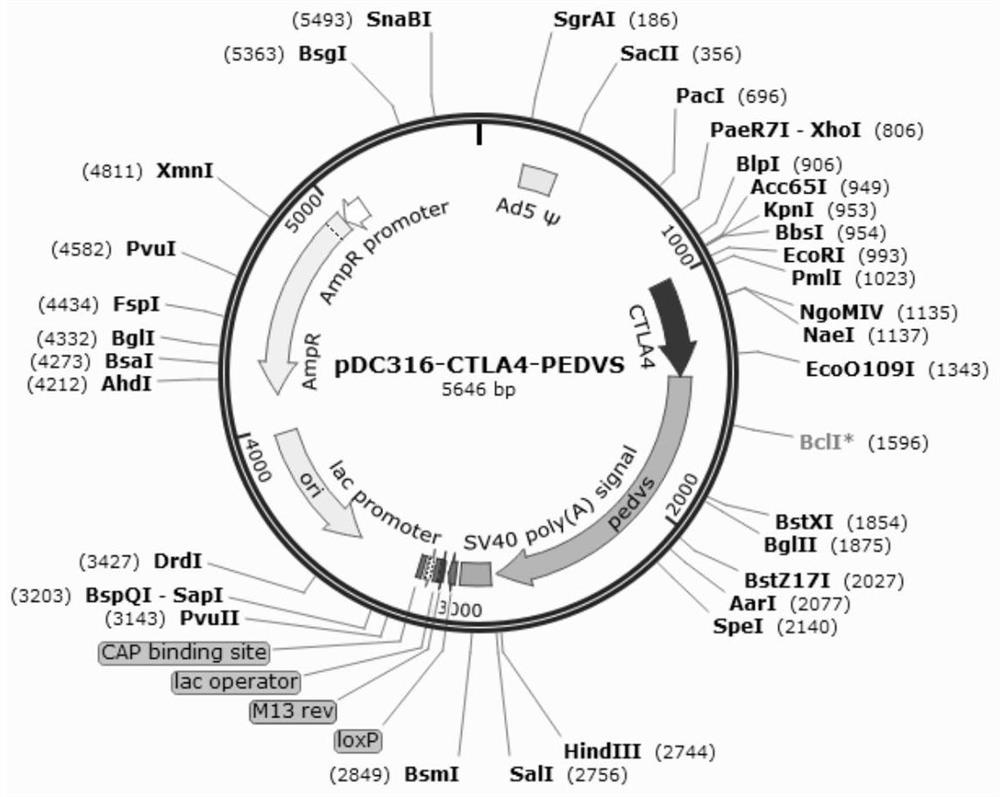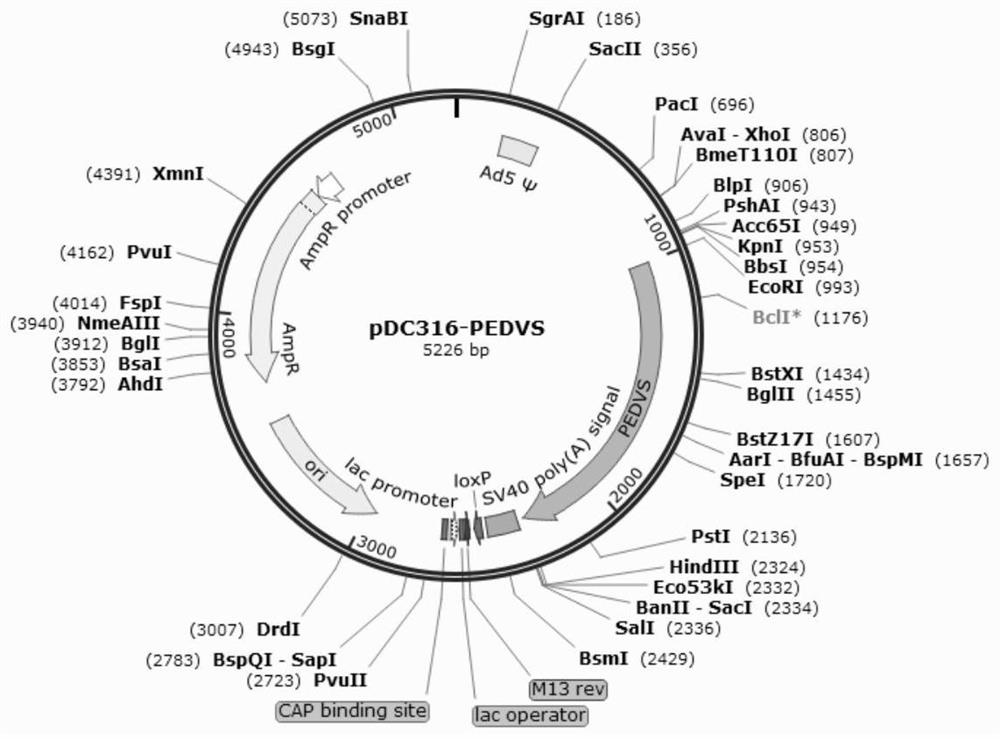Porcine epidemic diarrhea virus fusion protein as well as coding gene and application thereof
A porcine epidemic diarrhea and epidemic diarrhea technology, applied in the field of biotechnology, can solve the problems of infection, virus strain variation, poor effect, etc., and achieve the effect of good safety and high immune titer
- Summary
- Abstract
- Description
- Claims
- Application Information
AI Technical Summary
Problems solved by technology
Method used
Image
Examples
preparation example Construction
[0050] In some more specific embodiments, the preparation method of the recombinant vector comprises the following steps:
[0051] (1) artificially synthesize the fusion gene CTLA4-PEDVS of porcine CTLA4 gene and porcine epidemic diarrhea virus S gene (nucleotide sequence shown in SEQ ID NO.3);
[0052] (2) Subcloning the fusion gene CTLA4-PEDVS synthesized in step (1) onto the adenovirus shuttle vector plasmid P to obtain the adenovirus shuttle plasmid p-CTLA4-PEDVS;
[0053] (3) co-transfecting host cells with the adenovirus shuttle plasmid p-CTLA4-PEDVS obtained in step (2) and the adenovirus packaging vector;
[0054] (4) Collect the cell culture supernatant and the cell pellet lysate supernatant to obtain the crude extract of CTLA4-PEDVS recombinant adenovirus.
[0055] Specifically, in step (2), the adenovirus shuttle vector plasmid is pDC316.
[0056] Specifically, in step (3), the adenovirus packaging vector is pBHGlox(delta)E13Cre.
[0057] Specifically, in step (3...
Embodiment 1
[0059] Example 1 Construction and protein expression of pDC316-CTLA4-PEDVS and pDC316-PEDVS plasmids
[0060] 1.1 Fusion gene
[0061] (1) artificially synthesized porcine CTLA4 gene and porcine epidemic diarrhea virus S gene (the nucleotide sequence is shown in SEQ ID NO.3, using the fragment of the 450-890th amino acid in the conserved region of the strain S gene) fusion gene CTLA4- PEDVS; synthetic CTLA4-PEDVS fusion gene (as shown in SEQ ID NO.1);
[0062] (2) artificially synthesize the fusion gene CTLA4-PEDVS-1 of porcine CTLA4 gene and porcine epidemic diarrhea virus S gene (using the 493-708th amino acid fragment of strain S gene);
[0063] The nucleotide sequence of the fusion gene CTLA4-PEDVS-1 is shown in SEQ ID NO.7:
[0064] ATGGAAATGAAAGGGATGCACGTGGCCCAACCTGCAGTAGTGCTGGCCAACAGCCGGGGTGTTGCCAGCTTTGTGTGTGAGTATGGGTCTGCAGGCAAAGCTGCCGAGGTCCGGGTGACAGTGCTGCGGCGGGCCGGCAGCCAGATGACTGAAGTCTGTGCCGCGACATATACTGTGGAGGATGAGTTGACCTTCCTTGATGACTCTACATGCACTGGCACCTCCACCGAAAACAAAGTGA...
Embodiment 2
[0081] Example 2 Packaging recombinant adenovirus type 5 rAd-CTLA4-PEDVS, rAd-CTLA4-PEDVS-1 and rAd-PEDVS
[0082] During the process of packaging the recombinant virus, it was found that the full-length fragment of the S protein is difficult to export (probably because the fragment is too large), so the full-length fragment is not suitable for use as a recombinant adenovirus vector.
[0083] 2.1 Packaging recombinant adenovirus type 5
[0084] (1) Plant 1×10 in a 10cm petri dish 6 One HEK293 cell, cultivated until the cells cover 80-90% of the bottom of the dish;
[0085] (2) Use lipo2000 liposomes for transfection: Take 1 μg of pDC316-CTLA4-PEDVS, pDC316-CTLA4-PEDVS-1, pDC316-PEDVS plasmids and 3 μg of pBHGlox(delta)E13Cre plasmids and add them to 0.5 mL serum-free DMEM At the same time, add 10 μL lipo2000 to 0.5 mL serum-free DMEM medium and let stand at room temperature for 10 min;
[0086] (3) Add the solution of the plasmid in step (2) dropwise to the solution contain...
PUM
 Login to View More
Login to View More Abstract
Description
Claims
Application Information
 Login to View More
Login to View More - R&D
- Intellectual Property
- Life Sciences
- Materials
- Tech Scout
- Unparalleled Data Quality
- Higher Quality Content
- 60% Fewer Hallucinations
Browse by: Latest US Patents, China's latest patents, Technical Efficacy Thesaurus, Application Domain, Technology Topic, Popular Technical Reports.
© 2025 PatSnap. All rights reserved.Legal|Privacy policy|Modern Slavery Act Transparency Statement|Sitemap|About US| Contact US: help@patsnap.com



